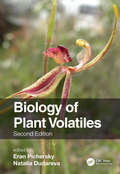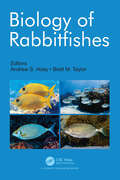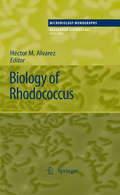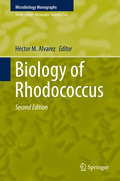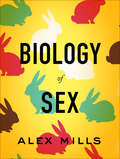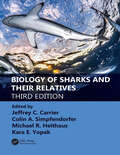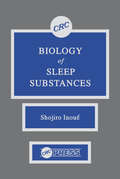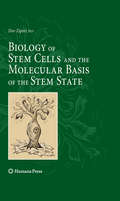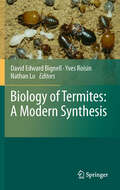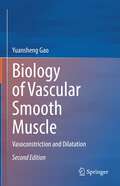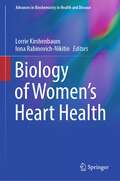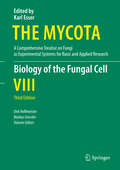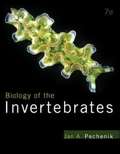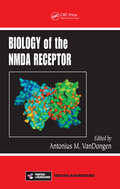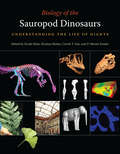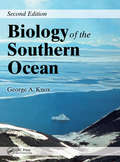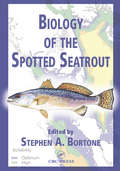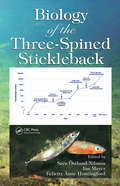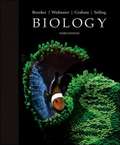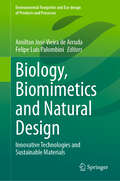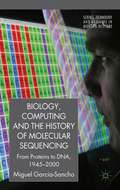- Table View
- List View
Biology of Plant Volatiles
by Eran Pichersky Natalia DudarevaPlant volatiles—compounds emitted from plant organs to interact with the surrounding environment—play essential roles in attracting pollinators and defending against herbivores and pathogenes, plant-plant signaling, and abiotic stress responses. Biology of Plant Volatiles, with contributions from leading international groups of distinguished scientists in the field, explores the major aspects of plant scent biology. Responding to new developments in the detection of the complex compound structures of volatiles, this book details the composition and biosynthesis of plant volatiles and their mode of emission. It explains the function and significance of volatiles for plants as well as insects and microbes whose interactions with plants are affected by these compounds. The content also explores the biotechnological and commercial potential for the manipulation of plant volatiles. Features: Combines widely scattered literature in a single volume for the first time, covering all important aspects of plant volatiles, from their chemical structures to their biosynthesis to their roles in the interactions of plants with their biotic and abiotic environment Takes an interdisciplinary approach, providing multilevel analysis from chemistry and genes to enzymology, cell biology, organismal biology and ecology Includes up-to-date methodologies in plant scent biology research, from molecular biology and enzymology to functional genomics This book will be a touchstone for future research on the many applications of plant volatiles and is aimed at plant biologists, entomologists, evolutionary biologists and researchers in the horticulture and perfume industries.
Biology of Rabbitfishes
by Andrew S. Hoey Brett M. TaylorRabbitfishes (family Siganidae) are a vital yet often overlooked group of fishes in coral reef and seagrass ecosystems native to the tropical and subtropical Indo-Pacific region. Known broadly as herbivores with low comparative species diversity among tropical fishes, what makes rabbitfishes distinctive and how do these traits contribute to their ecological significance? This book delves into the biology, ecology, evolution, and behaviour of rabbitfishes, from their nutritional adaptations to their complex social behaviours and life histories. It also explores recent invasions into new habitats, their role in fisheries and aquaculture, and highlights promising directions for future research on these essential marine species.
Biology of Rhodococcus (Microbiology Monographs #16)
by Héctor M. AlvarezRhodococcus, a metabolically versatile actinobacteria which is frequently found in the environment, has gained increasing interest due to its potential biotechnological applications. This Microbiology Monographs volume provides a thorough review of the various aspects of the biochemistry, physiology and genetics of the Genus Rhodococcus. Following an overview of its taxonomy, chapters cover the structural aspects of rhodococcal cellular envelope, genomes and plasmids, metabolic and catabolic pathways, such as those of aromatic compounds, steroids and nitriles, and desulfurization pathways, as well as the adaption to organic solvents. Further reviews discuss applications of Rhodococcus in the bioremediation of contaminated environments, in triacylglycerol accumulation, and in phytopathogenic strategies, as well as the potential of biosurfactants. A final chapter describes the sole pathogenic Rhodococcus member, R. equi.
Biology of Rhodococcus (Microbiology Monographs #16)
by Héctor M. AlvarezRhodococcus are metabolically versatile actinobacteria frequently found in the environment with potential applications in bioremediation, biotransformations and biocatalysis, among other biotechnological processes. These microorganisms are currently the subject of research in many countries of the world. The number of publications and patents on rhodococci has intensified significantly within the last years. In this context, the knowledge acquired during the last decade about basic aspects of Rhodococcus biology is significant and promising about their future prospects. Several genomic projects of Rhodococcus members are now available and in progress through public and private efforts due to the increasing interest in their use for biotechnology. The large Rhodococcus genomes containing a multiplicity of catabolic genes, a high genetic redundancy of biosynthetic pathways and a sophisticated regulatory network reflect the complexity of Rhodococcus biology. The combination of functional genomics studies with biochemical and physiological knowledge is providing new insights, which will enable the biotechnological use of rhodococci. This Microbiology Monographs volume provides a thorough review of many aspects of biochemistry, physiology and genetics of Rhodococcus, in the context of new genomic information. Expert international scientists contributed with reviews on the extraordinary capability of Rhodococcus genus for biodegradation of diverse compounds and bioremediation, biosynthesis of lipids and biosurfactants, adaptation and tolerance to solvents, interaction with metals and biotechnological applications. Chapters dealing with taxonomy, genomes and plasmids, and oligotrophic and central metabolism are also included in this volume. Moreover, the book includes basic aspects of the phytopathogenic R. fascians.
Biology of Sex
by Alex MillsBiology of Sex is a lively and intellectually challenging textbook. Mills analyzes the biological basis of sex by considering genetic, physiological, and evolutionary principles. In order to explain the biological aspects of human sex, he uses direct and intriguing comparisons with the many variations in sexual systems among non-human organisms. Text boxes provide fascinating examples: non-human species that cannibalize their partners during copulation, organisms that do not fall within one of two biological sexes, and species that “trick” others into raising their young. The author also explores questions such as: “Is sex only for reproduction?”, “Why is sex pleasurable?”, and “What are the roots of sexual conflict?” Intended primarily for readers without a science background, Biology of Sex provides novel content from the human and non-human worlds to introduce the complex subject of sex and reproduction.
Biology of Sharks and Their Relatives (CRC Marine Biology Series)
by Michael R. Heithaus Colin A. Simpfendorfer Jeffrey C. Carrier Kara E. YopakBiology of Sharks and Their Relatives is an award-winning and groundbreaking exploration of the fundamental elements of the taxonomy, systematics, physiology, and ecology of sharks, skates, rays, and chimera. This edition presents current research as well as traditional models, to provide future researchers with solid historical foundations in shark research as well as presenting current trends from which to develop new frontiers in their own work. Traditional areas of study such as age and growth, reproduction, taxonomy and systematics, sensory biology, and ecology are updated with contemporary research that incorporates emerging techniques including molecular genetics, exploratory techniques in artificial insemination, and the rapidly expanding fields of satellite tracking, remote sensing, accelerometry, and imaging. With two new editors and 90 contributors from the US, UK, South Africa, Portugal, France, Canada, New Zealand, Australia, India, Palau, United Arab Emirates, Micronesia, Sweden, Argentina, Indonesia, Cameroon, and the Netherlands, this third edition is the most global and comprehensive yet. It adds six new chapters representing extensive studies of health, stress, disease and pathology, and social structure, and continues to explore elasmobranch ecological roles and interactions with their habitats. The book concludes with a comprehensive review of conservation policies, management, and strategies, as well as consideration of the potential effects of impending climate change. Presenting cohesive and integrated coverage of key topics and discussing technological advances used in modern shark research, this revised edition offers a well-rounded picture for students and researchers.
Biology of Sleep Substances
by Shojiro InoueAll aspects of sleep sciences are included in this excellent resource text, with special reference to sleep substances and sleep modulators. The historical development of the theories of sleep are reviewed in conjunction with the technical problems. All candidate substances are overviewed as to their sites of presence, chemical nature, bioassay techniques, physiological and pharmacological effects. On the basis of a standardized methodology developed by the author, sleep-modulatory characteristics of some substances are compared and evaluated in quantitative terms. The sleep regulatory mechanisms, which are composed of complex neurohumoral subsystems, are analyzed from the results of recent neurophysiological and neuroendocrinological experiments. Furthermore, an evolutionary aspect of sleep substances is taken into consideration.Chapters Highlight:Techniques for isolation and evaluationProstaglandinsParadoxical sleep factorsSleep-promoting substances and nucleosides
Biology of Stem Cells and the Molecular Basis of the Stem State (Stem Cell Biology and Regenerative Medicine)
by Dov ZiporiBiology of Stem Cells and the Molecular Basis of the Stem State concentrates upon adult stem cells, particularly on mesenchymal cell populations, which is the author's area of expertise. The text offers the reader a detailed description of the emergence of stem cell research and the dogmas that were created during the first decades of analysis of stem cell properties, particularly those of hemopoietic stem cells. Biology of Stem Cells and the Molecular Basis of the Stem State also introduces the reader to the commonly accepted notions regarding stem cell biology, with an emphasis on an alternative view of stemness, i.e. the stem state. In keeping with the popularity of this topic, Biology of Stem Cells and the Molecular Basis of the Stem State addresses the major controversies and points of dispute, among researchers in the stem cell field. Overall, Biology of Stem Cells and the Molecular Basis of the Stem State presents a well-rounded dialogue about stem cells as it not only concentrates upon the biological elements of stem cell, but also addresses the controversy and hype currently enveloping this popular subject.
Biology of Termites: A Modern Synthesis
by David Edward Bignell Yves Roisin Nathan LoBiology of Termites, a Modern Synthesis brings together the major advances in termite biology, phylogenetics, social evolution and biogeography. In this new volume, David Bignell, Yves Roisin and Nathan Lo have brought together leading experts on termite taxonomy, behaviour, genetics, caste differentiation, physiology, microbiology, mound architecture, biogeography and control. Very strong evolutionary and developmental themes run through the individual chapters, fed by new data streams from molecular sequencing, and for the first time it is possible to compare the social organisation of termites with that of the social Hymenoptera, focusing on caste determination, population genetics, cooperative behaviour, nest hygiene and symbioses with microorganisms. New chapters have been added on termite pheromones, termites as pests of agriculture and on destructive invasive species.
Biology of Turtles: From Structures to Strategies of Life
by Vincent Bels Jeanette Wyneken Matthew H. GodfreyFeaturing in-depth contributions from an international team of experts, the Biology of Turtles provides the first comprehensive review of the Testudinata. The book starts with the premise that the structure of turtles is particularly interesting and best understood within the context of their development, novelty, functional diversity, and e
Biology of Vascular Smooth Muscle: Vasoconstriction and Dilatation
by Yuansheng GaoThis book provides a concise yet comprehensive review of the morphological, biochemical, electrical, mechanical, and metabolic properties of vascular smooth muscle, the regulation of vascular activities and the intracellular signaling involved. It particularly focuses on recently identified vasoactive agents, enzymes and transduction mechanisms. It also discusses the latest findings in the regulation of cerebral, coronary and pulmonary circulation as well as vascular activity under hypoxia and ageing. The contraction and dilatation activities of vasculature are of fundamental importance for maintaining circulation homeostasis and adapting physiological changes. Over the last four decades, there have been significant advances in our understanding of the biochemical, structural, genetic, physiological, and pharmacological aspects of vascular activity regulation, and these insights into the responsiveness of blood vessels under normal and pathophysiological conditions help to provide valuable weapons in the fight vascular diseases. The book is of interest to researchers and graduate students, both in basic research and in clinic settings, in the field of vascular biology.
Biology of Vascular Smooth Muscle: Vasoconstriction and Dilatation
by Yuansheng GaoThis book provides a concise yet comprehensive review of the morphological, biochemical, electrical, mechanical, and metabolic properties of vascular smooth muscle, the regulation of vascular activities and the intracellular signaling involved. It particularly focuses on newly identified vasoactive agents, enzymes and transduction mechanisms. It also discusses the latest findings in the regulation of cerebral, coronary and pulmonary circulation as well as vascular activity under hypoxia and ageing. The second edition intends to update the contents of the first edition with the latest achievements in the regulation of vascular activities from biochemical, structural, genetic, physiological, and pharmacological aspects. In addition, two new chapters related to microRNA and extracellular vesicles have been added to reflect their newly discovered important roles in vascular activities. The contraction and dilatation activities of vasculature are of fundamental importance for maintaining circulation homeostasis and adapting to physiological changes. Over the last four decades, there have been significant advances in our understanding of the biochemical, structural, genetic, physiological, and pharmacological aspects of vascular activity regulation, and these insights into the responsiveness of blood vessels under normal and pathophysiological conditions help to provide valuable weapons in the fight vascular diseases. The book is of interest to researchers and graduate students, both in basic research and in clinic settings, in the field of vascular biology.
Biology of Women’s Heart Health (Advances in Biochemistry in Health and Disease #26)
by Lorrie Kirshenbaum Inna Rabinovich-NikitinCardiovascular disease (CVD) is the leading cause of morbidity and mortality in women and men worldwide and represents a major financial burden to world health care systems. Importantly, CVD has eclipsed cancer as the leading cause of death for women globally. Through advancements in research and clinical testing, the symptoms and risk factors for CVD have been well established for men, but not for women. Consequently, there is an immediate need for new innovative research that will bridge this gap and allow for improved early diagnosis and treatment of CVD in women. This book will serve as a guide for health care providers to better understand the physiological, biochemical, and genetic differences in heart disease in women with the goal of providing improved education, awareness and treatment of cardiovascular disease in women. The book will cover topics such as: sex dependent clinical outcomes of cardiovascular disease, cardiac protection by estrogen, cardiac health during menopause, cardiac rehabilitation programs, fitness and exercise, cardio-oncology, shift work and the CVD risk, and pregnancy related CVD.
Biology of the Chemotactic Responses
by J. M. Lackie P. C. WilkinsonThe study of chemotactic reactions has always attracted scientists from many disciplines. Not only does it have an intrinsic fascination as a form of cellular behaviour, but it is now beginning to be possible to approach it at the molecular level. In at least three widely diverse cell types, the enterobacteria, the cellular slime moulds and the mammalian leucocytes, rapid progress is being made in understanding the underlying mechanisms of signal perception and message transduction.
Biology of the Fungal Cell (The Mycota #8)
by Dirk Hoffmeister Markus GresslerThis volume provides a detailed look at various biochemical and developmental aspects of fungal cell biology, and offers extensive information on model organisms of filamentous fungi, such as Aspergillus, and yeasts, such as Saccharomyces, while also highlighting molecular differences between ascomycetes and basidiomycetes. The book’s seven chapters, prepared by experts in the fields of mycology, have been grouped into two closely connected sections: “Fungal Cell Growth” and “Signals and Development”. The first section addresses bio-molecular mechanisms of fungal cell division and polarized cell growth, with a special emphasis on cell-cell connections, cell wall synthesis, and directed protein transport. In turn, the second section describes the intra- and extracellular signals that set off biochemical and conformational changes of cell type during development. Here, the authors focus on the molecular signalling pathways, including their impact on plant-fungus interactions, referred to as ectomycorrhizal symbiosis. Given its scope, the book offers a valuable guide for all microbiologists, geneticists, cell biologists, biochemists and plant biologists, as well as advanced students of biology, who share an interest in the field of mycology.
Biology of the Invertebrates
by Jan PechenikThis textbook is the most concise and readable invertebrates book in terms of detail and pedagogy (other texts do not offer boxed readings, a second color, end of chapter questions, or pronunciation guides). All phyla of invertebrates are covered (comprehensive) with an emphasis on unifying characteristics of each group.
Biology of the NMDA Receptor
by Antonius M. VanDongenThe NMDA receptor plays a critical role in the development of the central nervous system and in adult neuroplasticity, learning, and memory. Therefore, it is not surprising that this receptor has been widely studied. However, despite the importance of rhythms for the sustenance of life, this aspect of NMDAR function remains poorly studied. Written
Biology of the Sauropod Dinosaurs: Understanding the Life of Giants (Life of the Past)
by Nicole Klein, Kristian Remes, Carole T. Gee and P. Martin SanderSauropods, those huge plant-eating dinosaurs, possessed bodies that seem to defy every natural law. What were these creatures like as living animals and how could they reach such uniquely gigantic sizes? A dedicated group of researchers in Germany in disciplines ranging from engineering and materials science to animal nutrition and paleontology went in search of the answers to these questions. Biology of the Sauropod Dinosaurs reports on the latest results from this seemingly disparate group of research fields and integrates them into a coherent theory regarding sauropod gigantism. Covering nutrition, physiology, growth, and skeletal structure and body plans, this volume presents the most up-to-date knowledge about the biology of these enormous dinosaurs.
Biology of the Southern Ocean (CRC Marine Biology Series)
by George A. KnoxFirst published in 1993, The Biology of the Southern Ocean has been referred to as international research at its best and an invaluable reference. Drawing on the considerable volume of information published in the last ten years, this second edition retains the format that made the first edition a popular bestseller, while updating the information
Biology of the Spotted Seatrout (CRC Marine Biology Series)
by Stephen A. BortoneThe spotted seatrout is an important species not only for recreational and commercial fisheries, but also as an integral part of many estuarine ecosystems. As one of the few fishes that live its entire life within an estuarine system, the species has tremendous potential as a monitor or sentinel for estuarine conditions. Prepared by the foremost au
Biology of the Three-Spined Stickleback (CRC Marine Biology Series)
by Sara Östlund-Nilsson Ian Mayer Felicity Anne HuntingfordHighlighting the growing importance of the sticklebacks as a model species in emerging fields such as molecular genetics, genomics, and environmental toxicology, Biology of the Three-Spined Stickleback examines data from researchers who use studies of the stickleback to address a wide range of biological issues. This state-of-the-art volume
Biology, 3rd Edition
by Robert J. Brooker Linda Graham Peter Stiling Eric WidmaierThe first and second editions of BIOLOGY, written by Dr. Rob Brooker, Dr. Eric Widmaier, Dr. Linda Graham, and Dr. Peter Stiling, has reached thousands of students and provided them with an outstanding view of the biological world. Now, the third edition has gotten even better! The author team is dedicated to producing the most engaging and current text that is available for undergraduate students who are majoring in biology. The authors want students to be inspired by the field of biology and become critical thinkers. They understand the goal of a professor is to prepare students for future course work, lab experiences, and careers in the sciences. Building on the successes of the first and second editions, the third edition reflects a focus on core competencies and provides a more learner-centered approach. The strength of an engaging and current text is improved with the addition of new pedagogical features that direct the students' learning goals and provide opportunities for assessment, to determine if students understand the concepts.
Biology, Biomimetics and Natural Design: Innovative Technologies and Sustainable Materials (Environmental Footprints and Eco-design of Products and Processes)
by Felipe Luis Palombini Amilton José Vieira de ArrudaFor billions of years, nature has provided efficient solutions to complex problems, by means of natural selection, in a harsh environment that only the fittest organisms survived. Such sustainable – still ruthless – driven evolution can be explored by designers, architects, engineers and more for the development of innovative projects. Biomimetics makes the link between Biology and Design, where features like shapes, mechanisms, colors, structures, and more can be analyzed, organized, modeled, and simulated for application in multiple creations. Therefore, such knowledge can contribute to more efficient and innovative solutions to many fields of applied science. This project aims to highlight some of the recent technological breakthroughs in Biology, Biomimetics and Natural Design that contribute to the development of sustainable and innovative materials and projects. This work consists of contributions from some of the main international groups of Biomimetics, exhibiting exciting cases of how technological advancements are leading to improved design solutions as well as shaping our very comprehension of nature and its complex organization.
Biology, Chemistry and Applications of Apocarotenoids
by Siva Ramamoorthy Renata Rivera Madrid C George DossCarotenoids are a large class of isoprenoid pigments produced by plants and certain microbes. More than 700 naturally occurring carotenoids have been identified. Apocarotenoids are tailored from carotenoids by oxidative enzymes. Apocarotenoids act as visual or volatile signals to attract pollinating and seed dispersal agents. They are also the key players in allelopathic interactions and plant defense. Biology, Chemistry and Applications of Apocarotenoids provides detailed account of the fundamental chemistry of apocarotenoids and the basic methods used in carotenoid research, and critical discussions of the biochemistry, functions, and applications of these important compounds. Topics covered in the proposed book include various aspects of the roles of apocarotenoids in colour and colouration, photosynthesis and other photofunctions and protection. The formation and roles of carotenoid metabolites and breakdown products as perfume/aroma compounds are also be outlined. Features: Provides an organized overview of apocarotenoids and their chemistry and biological functions Focuses on recent discoveries on apocarotenoids, their nature and functions. Details potential uses of apocarotenoids in agriculture, pharmacy, food industry, and apocarotenoid production at industrial level This book has been written by leading experts in apocarotenoid research and gives a comprehensive overview on the diversity of apocarotenoid compounds and would serve as a reference book for researches in Plant Physiology, Molecular Biology, Biochemistry, Biophysics and Medicine.
Biology, Computing, and the History of Molecular Sequencing: From Proteins to DNA, 1945-2000 (Science, Technology and Medicine in Modern History)
by Miguel García-SanchoSequencing is often associated with the Human Genome Project and celebrated achievements concerning the DNA molecule. However, the history of this practice comprises not only academic biology, but also the world of computer-assisted information management. The book uncovers this history, qualifying the hype and expectations around genomics.
